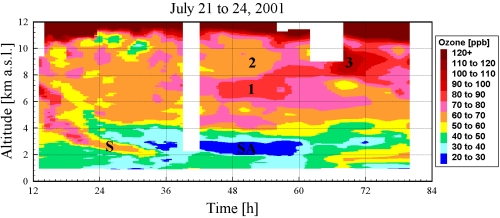Results: Intercontinental Transport
Contact: Thomas Trickl
In May 1996 a four-day sounding series with the IMK-IFU ozone lidar, assisted by FLEXTRA ![]() trajectory modelling, yielded the first detection of significant North American ozone plumes the free troposphere over Europe (VOTALP
trajectory modelling, yielded the first detection of significant North American ozone plumes the free troposphere over Europe (VOTALP ![]() project, [Trickl et al., 2003]). These polluted air masses mostly arrive at altitudes above 3.5 km and, thus, can rarely be observed even at Alpine summit stations. In the figure below shows a temporal evolution of the ozone distribution typical of the beginning of a high pressure period. The observational period starts with a stratospheric air intrusion (S) followed by low-ozone air from the subtropical Atlantic (SA). Above 4 km air from across the Atlantic seen. The ozone maxima around the labels 1 to 3 with up to 120 ppb are ascribed to mixed input from East Asia, the United States and the stratosphere above the Pacific. Around Label 3 the stratospheric influence is almost exclusive. Such layers are repeatedly observed one or two days after the beginning of high pressure periods, which suggests a possibly important mechanism for the import of stratospheric ozone in the troposphere.
project, [Trickl et al., 2003]). These polluted air masses mostly arrive at altitudes above 3.5 km and, thus, can rarely be observed even at Alpine summit stations. In the figure below shows a temporal evolution of the ozone distribution typical of the beginning of a high pressure period. The observational period starts with a stratospheric air intrusion (S) followed by low-ozone air from the subtropical Atlantic (SA). Above 4 km air from across the Atlantic seen. The ozone maxima around the labels 1 to 3 with up to 120 ppb are ascribed to mixed input from East Asia, the United States and the stratosphere above the Pacific. Around Label 3 the stratospheric influence is almost exclusive. Such layers are repeatedly observed one or two days after the beginning of high pressure periods, which suggests a possibly important mechanism for the import of stratospheric ozone in the troposphere.

Characteristic layering of ozone obtained from lidar measurements during a high-pressure period in July 2001 (AFO2000 project ATMOFAST)
Further studies of intercontinental transport have been devoted to observations of forest-fire plumes, motivated in particular by the increase in wild fires reported for North America. The most spectacular aerosol measurements have been made in the case of large fires in Canada or Alaska. An example for lidar measurements during the overpass of such a boreal fire plume, observed for many days during the ICARTT ![]() field campaign in summer 2004, is shown below. The equivalent visual range at the aerosol peak at 5.1 km is about 29 km.
field campaign in summer 2004, is shown below. The equivalent visual range at the aerosol peak at 5.1 km is about 29 km.

Aerosol backscatter coefficients obtained by lidar measurements on July 22, 2004.
Reference:
Trickl, T., Cooper, O. C., Eisele, H., James, P., Mücke, R., Stohl, A.: Intercontinental transport and its influence on the ozone concentrations over central Europe: Three case studies, J. Geophys. Res., 108, 8530, doi: 10.1029/2002JD002735, STA 15, 23 pp., 2003